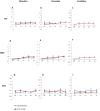Survival and Inactivation by Advanced Oxidative Process of Foodborne Viruses in Model Low-Moisture Foods
- PMID: 33501613
- PMCID: PMC7882587
- DOI: 10.1007/s12560-020-09457-7
Survival and Inactivation by Advanced Oxidative Process of Foodborne Viruses in Model Low-Moisture Foods
Abstract
Enteric viruses, such as human norovirus (NoV) and hepatitis A virus (HAV), are the major causes of foodborne illnesses worldwide. These viruses have low infectious dose, and may remain infectious for weeks in the environment and food. Limited information is available regarding viral survival and transmission in low-moisture foods (LMF). LMFs are generally considered as ready-to-eat products, which undergo no or minimal pathogen reduction steps. However, numerous foodborne viral outbreaks associated with LMFs have been reported in recent years. The objective of this study was to examine the survival of foodborne viruses in LMFs during 4-week storage at ambient temperature and to evaluate the efficacy of advanced oxidative process (AOP) treatment in the inactivation of these viruses. For this purpose, select LMFs such as pistachios, chocolate, and cereal were inoculated with HAV and the norovirus surrogates, murine norovirus (MNV) and feline calicivirus (FCV), then viral survival on these food matrices was measured over a four-week incubation at ambient temperature, by both plaque assay and droplet-digital RT-PCR (ddRT-PCR) using the modified ISO-15216 method as well as the magnetic bead assay for viral recovery. We observed an approximately 0.5 log reduction in viral genome copies, and 1 log reduction in viral infectivity for all three tested viruses following storage of select inoculated LMFs for 4 weeks. Therefore, the present study shows that the examined foodborne viruses can persist for a long time in LMFs. Next, we examined the inactivation efficacy of AOP treatment, which combines UV-C, ozone, and hydrogen peroxide vapor, and observed that while approximately 100% (4 log) inactivation can be achieved for FCV, and MNV in chocolate, the inactivation efficiency diminishes to approximately 90% (1 log) in pistachios and 70% (< 1 log) in cereal. AOP treatment could therefore be a good candidate for risk reduction of foodborne viruses from certain LMFs depending on the food matrix and surface of treatment.
Keywords: Advanced oxidative process; Bead-based assay; Hepatitis A virus; Low-moisture foods; Norovirus surrogates.
Figures




Similar articles
-
Evaluation of Bead-Based Assays for the Isolation of Foodborne Viruses from Low-Moisture Foods.J Food Prot. 2020 Mar 1;83(3):388-396. doi: 10.4315/0362-028X.JFP-19-345. J Food Prot. 2020. PMID: 32050030
-
Inactivation of murine norovirus and hepatitis A virus on fresh raspberries by gaseous ozone treatment.Food Microbiol. 2018 Apr;70:1-6. doi: 10.1016/j.fm.2017.08.010. Epub 2017 Aug 19. Food Microbiol. 2018. PMID: 29173615
-
Comparison of chlorine and peroxyacetic-based disinfectant to inactivate Feline calicivirus, Murine norovirus and Hepatitis A virus on lettuce.Int J Food Microbiol. 2011 Nov 15;151(1):98-104. doi: 10.1016/j.ijfoodmicro.2011.08.011. Epub 2011 Aug 22. Int J Food Microbiol. 2011. PMID: 21924791
-
Thermal Inactivation of Foodborne Enteric Viruses and Their Viral Surrogates in Foods.J Food Prot. 2015 Aug;78(8):1597-617. doi: 10.4315/0362-028X.JFP-14-487. J Food Prot. 2015. PMID: 26219377 Review.
-
Foodborne viruses: an emerging problem.Int J Food Microbiol. 2004 Jan 1;90(1):23-41. doi: 10.1016/s0168-1605(03)00169-7. Int J Food Microbiol. 2004. PMID: 14672828 Free PMC article. Review.
Cited by
-
Inactivation of Foodborne Viruses by UV Light: A Review.Foods. 2021 Dec 18;10(12):3141. doi: 10.3390/foods10123141. Foods. 2021. PMID: 34945692 Free PMC article. Review.
-
How Long Do Microorganisms Survive and Persist in Food? A Systematic Review.Microorganisms. 2025 Apr 14;13(4):901. doi: 10.3390/microorganisms13040901. Microorganisms. 2025. PMID: 40284737 Free PMC article. Review.
-
Development of an RNA Extraction Protocol for Norovirus from Raw Oysters and Detection by qRT-PCR and Droplet-Digital RT-PCR.Foods. 2021 Aug 4;10(8):1804. doi: 10.3390/foods10081804. Foods. 2021. PMID: 34441580 Free PMC article.
-
Efficacy of washing produce in removing human coronavirus OC43 and murine norovirus.J Appl Microbiol. 2022 Sep;133(3):1800-1807. doi: 10.1111/jam.15667. Epub 2022 Jul 5. J Appl Microbiol. 2022. PMID: 35702940 Free PMC article.
-
Detection of Foodborne Viruses in Dates Using ISO 15216 Methodology.Viruses. 2025 Jan 26;17(2):174. doi: 10.3390/v17020174. Viruses. 2025. PMID: 40006929 Free PMC article.
References
-
- Anonymous. (2019). Retrieved from http://www.inspection.gc.ca/about-the-cfia/newsroom/food-recall-warnings....
-
- Bosch A, Gkogka E, Le Guyader FS, Loisy-Hamon F, Lee A, van Lieshout L, Marthi B, Myrmel M, Sansom A, Schultz AC, Winkler A, Zuber S, Phister T. Foodborne viruses: Detection, risk assessment, and control options in food processing. International Journal of Food Microbiology. 2018;285:110–128. doi: 10.1016/j.ijfoodmicro.2018.06.001. - DOI - PMC - PubMed
Publication types
MeSH terms
Substances
LinkOut - more resources
Full Text Sources
Other Literature Sources
Medical

